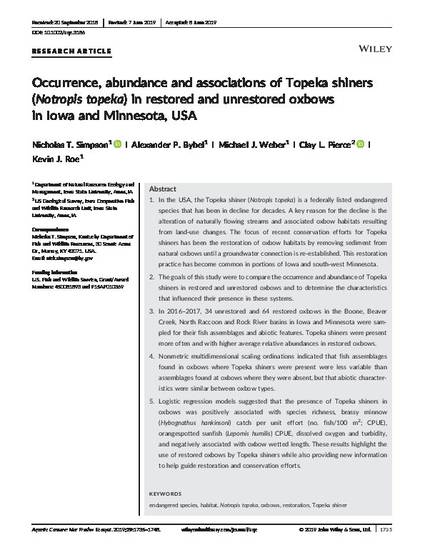
Article
Occurrence, abundance and associations of Topeka shiners (Notropis topeka) in restored and unrestored oxbows in Iowa and Minnesota, USA
Aquatic Conservation: Marine and Freshwater Ecosystems
Document Type
Article
Disciplines
Publication Version
Published Version
Publication Date
10-1-2019
DOI
10.1002/aqc.3186
Abstract
- In the USA, the Topeka shiner (Notropis topeka) is a federally listed endangered species that has been in decline for decades. A key reason for the decline is the alteration of naturally flowing streams and associated oxbow habitats resulting from land‐use changes. The focus of recent conservation efforts for Topeka shiners has been the restoration of oxbow habitats by removing sediment from natural oxbows until a groundwater connection is re‐established. This restoration practice has become common in portions of Iowa and south‐west Minnesota.
- The goals of this study were to compare the occurrence and abundance of Topeka shiners in restored and unrestored oxbows and to determine the characteristics that influenced their presence in these systems.
- In 2016–2017, 34 unrestored and 64 restored oxbows in the Boone, Beaver Creek, North Raccoon and Rock River basins in Iowa and Minnesota were sampled for their fish assemblages and abiotic features. Topeka shiners were present more often and with higher average relative abundances in restored oxbows.
- Nonmetric multidimensional scaling ordinations indicated that fish assemblages found in oxbows where Topeka shiners were present were less variable than assemblages found at oxbows where they were absent, but that abiotic characteristics were similar between oxbow types.
- Logistic regression models suggested that the presence of Topeka shiners in oxbows was positively associated with species richness, brassy minnow (Hybognathus hankinsoni) catch per unit effort (no. fish/100 m2; CPUE), orangespotted sunfish (Lepomis humilis) CPUE, dissolved oxygen and turbidity, and negatively associated with oxbow wetted length. These results highlight the use of restored oxbows by Topeka shiners while also providing new information to help guide restoration and conservation efforts.
Rights
Works produced by employees of the U.S. Government as part of their official duties are not copyrighted within the U.S. The content of this document is not copyrighted.
Language
en
File Format
application/pdf
Citation Information
Nicholas T. Simpson, Alexander P. Bybel, Michael J. Weber, Clay L. Pierce, et al.. "Occurrence, abundance and associations of Topeka shiners (Notropis topeka) in restored and unrestored oxbows in Iowa and Minnesota, USA" Aquatic Conservation: Marine and Freshwater Ecosystems Vol. 29 Iss. 10 (2019) p. 1735 - 1748 Available at: http://works.bepress.com/kevin_roe/23/

This article is published as Simpson, Nicholas T., Alexander P. Bybel, Michael J. Weber, Clay L. Pierce, and Kevin J. Roe. "Occurrence, abundance and associations of Topeka shiners (Notropis topeka) in restored and unrestored oxbows in Iowa and Minnesota, USA." Aquatic Conservation: Marine and Freshwater Ecosystems 29, no. 10 (2019): 1735-1748. doi: 10.1002/aqc.3186.